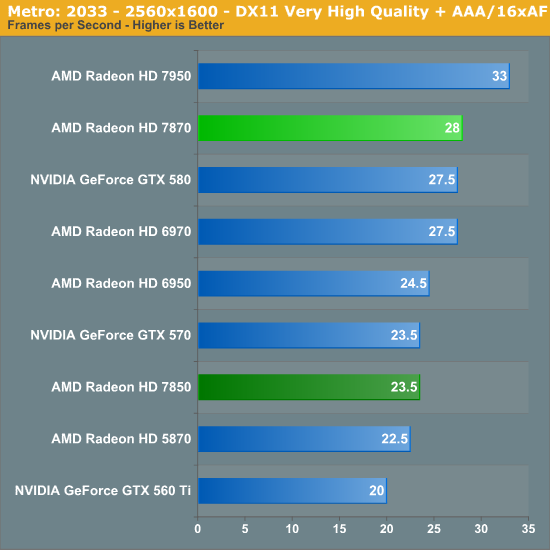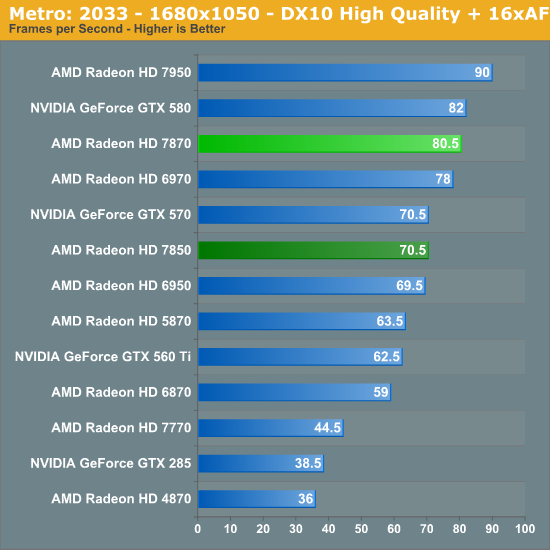AMD Radeon HD 7870 GHz Edition & Radeon HD 7850 Review: Rounding Out Southern Islands
by Ryan Smith on March 5, 2012 12:01 AM ESTMetro 2033
Paired with Crysis as our second behemoth FPS is Metro: 2033. Metro gives up Crysis’ lush tropics and frozen wastelands for an underground experience, but even underground it can be quite brutal on GPUs, which is why it’s also our new benchmark of choice for looking at power/temperature/noise during a game. If its sequel due this year is anywhere near as GPU intensive then a single GPU may not be enough to run the game with every quality feature turned up.



Metro ends up being an even better test for the 7800 series than Crysis was. At 1920 the 7870 ties the GTX 580 while taking a 17% lead over the GTX 570 and a much smaller lead over the 6970. The 7850 on the other hand is slightly behind the 6950, but is itself tied with the GTX 570 and well ahead of the GTX 560 Ti.
Interestingly, in spite of being built from the same architecture the 7950’s lead decreases some here. At 1920 it’s now only 13% ahead of the 7870, though in all likelihood it’s just enough of a difference that the 7870 isn’t going to be fully playable at these settings. As it turns out the gap between the 7870 and 7850 ends up being larger, with the 7870 enjoying a 17% advantage.










173 Comments
View All Comments
arjuna1 - Monday, March 5, 2012 - link
Metro 2033 (the highest settings bench)Radeon 7950 33fps
Radeon 6970 27.5fps
Radeon 6870 32fps (the second highest bench)
Weee!!! $400+ for 5.5fps more.
Not sure about you, but to me, spending that kind of cash for an imperceptible increase in performance is having no sense of money's worth.
This generation of cards can safely be skipped until the 8xxx/7xx series from both AMD and NVIDIA.
Death666Angel - Tuesday, March 6, 2012 - link
Picking up one specific benchmark to underline your point. Great reasoning skills, you should join a debate team! Also, that 5.5fps is still 20%, with the good track record of overclockability, it can reach as much as 40%. But you stick to your point.arjuna1 - Tuesday, March 6, 2012 - link
What? were you expecting me to post a powerpoint presentation for just for you??The numbers are there, look at them if you want, but hey, be stuck in your point, only a frustrated basement geek can think in way to justify spending $400 +/- for less than 50% increase in performance.
Be careful of not falling of that horse, seems pretty high.
sseemaku - Tuesday, March 6, 2012 - link
Please check the avg frame rate improvements, not some specific results. But everyone agrees that 7xxx cards are a bit overpriced and that's because they don't have competition right now. If you worry about power consumption, buy these cards now. Or more interested in price/performance, wait till Kepler is released.arjuna1 - Tuesday, March 6, 2012 - link
I can agree with that, after Kepler is release prices will go down and maybe then the 7xxx series will increase in the perceived value.CeriseCogburn - Thursday, March 8, 2012 - link
If there's no competition then they aren't overpriced because they cannot be touched by anything, hence making their price absolutely correct !!!I call that "reality".
If Kepler blows their doors off, their price will fall. That's reality too.
It's time for all the amd is cheaper crud to go the way of the dinosaur.
Recently a 460 was an unbeatable value. Then a 560ti was as unbeatable value. Currently a 6870 is an unbeatable value.
These things happen, and a deal is not the general aspect of the video card prices, which generally speaking wind up right where they should be.
The deal is the exception to the usual rule across the board, and "the deal" as in "big price drop" is usually just one card here or there for a short period of time.
CeriseCogburn - Thursday, March 8, 2012 - link
Radeon cards have been coming out at $700 and $600 and $500+ for a long time man - even with competition.I don't know what planet you people come from when the constant repetition of "it sounds good" becomes an absolute meme and ongoing restated theme but in no way reflects even a tiny kernel of truth as far as reality goes.
CeriseCogburn - Friday, March 9, 2012 - link
Yes dagamer34, Ryan praises amd for drying up their 6000 series channel with such precision. Then we get this praise - the perfect price structure by AMD, and "it's conservative pricing" according to the author even though it's $40 and $30 higher than it's Nvidia counterpart..." With AMD targeting the ~$320 570 and ~$210 560 Ti and given their conservative pricing on the rest of Southern Islands, it should come as no surprise that the 7800 series is priced equally conservatively. The 7870 will have an MSRP of $350, while the 7850 will have an MSRP of $250. With the 7800 series completing the launch of Southern Islands, this gives AMD a consistent price structure for the entire family: $550, $450, $350, $250, $159, and $109."
---
I see. So more expensive is conservative, and the 6 AMD price figures are perfect and consistent...
I am so sick of it...
Falkenad2 - Monday, March 5, 2012 - link
Thus far, AMD's first foray into 28nm graphics has been unimpressive. From a price/performance standpoint, the 7000 series has not given the usual incentives for upgrading that is regularly associated with the move to a new node. I hope a strong competitor from nVidia is on the way, as that would bode well for consumers such as ourselves. As it stands, the 7000 series lacks value except at the very high end, where price/performance is of little concern.Kaboose - Monday, March 5, 2012 - link
Price vs. performance is not the only factor, some people are concerned with power draw as well. Others are interested in temps, and noise. The price could use some work (come on Nvidia) but besides that the 7xxx series has been fairly impressive in regards to overclocking, power, temp, and noise.